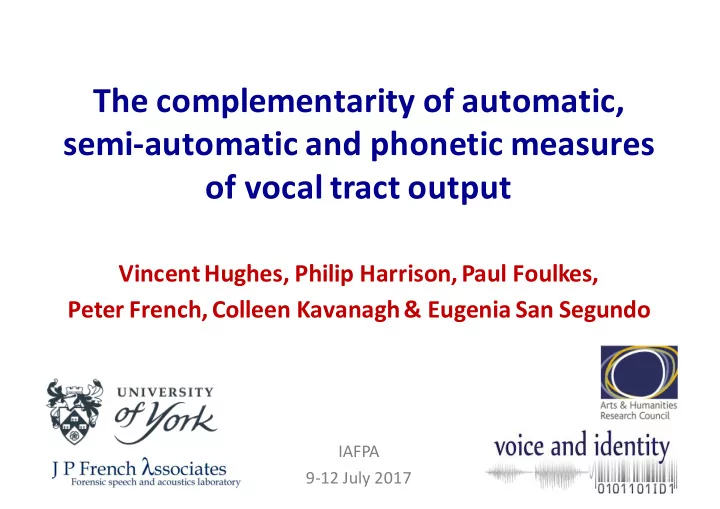

The complementarity of automatic, semi-automatic and phonetic measures of vocal tract output Vincent Hughes, Philip Harrison, Paul Foulkes, Peter French, Colleen Kavanagh & Eugenia San Segundo IAFPA 9-12 July 2017
1. Forensic voice comparison (FVC) • three common methods of analysis: linguistic-phonetic automatic (ASR) semi-automatic (S-ASR) 2
1. FVC: Combining approaches • largely developed in isolation – but ultimate aim is the same… • increasing focus on combination of (S-)ASR and ling-phon approaches – (H)ASR element of NIST (Greenberg et al. 2010) – G’ment labs in Germany and Sweden use combined approach in casework – Zhang et al (2013), Gonzalez-Rodriguez et al (2014) 3
2. This study: Features • measures of long term vocal tract (VT) output – automatic: MFCCs – semi-automatic: LTFDs – ling-phon: supralaryngeal voice quality (VQ) • why? – commonly used in each approach – encode considerable speaker information – in principle model the same thing 4
2. This study: Research questions 1. how does the performance of MFCCs and LTFDs compare on the same data? 2. does fusion of MFCC and LTFD systems improve performance over MFCCs only? 3. can supralaryngeal VQ explain the errors made by the (S-)ASR system? With a view to the future… what about laryngeal VQ? 5
3. Method • DyViS (Nolan et al. 2009) – Task 1: mock police interview – Task 2: telephone conversation with accomplice • pre-processing – manual editing – silences (> 100ms) removed – sections of clipping removed 6
3. Method: (S-)ASR • for ( semi- ) automatic features: – audio segmented into Cs and Vs (StkCV) – 94 /100 speakers with > 60s of Vs – samples reduced to 60s net Vs (6000 frames) – 20ms frames/ 10ms shift (hamming window) MFCCs LFTDs (M)LTFDs 12 MFCCs F1-F4 frequencies F1-F4 (Mel) frequencies 12 Δs F1-F4 Δs F1-F4 (Mel) Δs 12 ΔΔs F1-F4 bandwidths F1-F4 (Mel) bandwidths 7
3. Method: (S-)ASR • 94 speakers divided into sets: – training (31 speakers) – test (31 speakers) – reference (32 speakers) • SS and DS LRs computed – Task 1 = suspect/ Task 2 = offender – GMM-UBM (w. MAP adaptation) 8
3. Method: (S-)ASR • logistic regression calibration/fusion: – applied separately for individual and combined systems • system validity: – Equal error rate (EER): – Log LR Cost Function ( C llr ; Brümmer & du Preez 2006 ) 9
3. Method: Voice quality • auditory based analysis using modified VPA – Laver et al (1981); San Segundo et al (submitted) – 25 supralaryngeal features – 7 laryngeal features • Task 2: 100 speakers – PFo, PFr, ESS produced VPAs independently – agreed VPA profiles (after calibration) 10
4. Results: MFCCs and LTFDs 11
4. Results: Fusion ✓ ✓ ✗ ✗ 12
4. Results: Fusion Best performance overall: MFCCs+Δs+ΔΔs and LTFDs EER = 3.23% C llr = 0.137 13
4. Results: Supralaryngeal VQ • best system = 14 errors – 13 false acceptances (DS producing SS evidence) – what is it about these speakers? • 9 involved speakers #067 and #072 – fairly typical supralaryngeal VQ profiles – non-neutral for: advance tongue tip, fronted tongue body, nasality – easily confused with other speakers? 14
4. Results: Supralaryngeal VQ atypical VQ typical less confusable (S-)ASR more confusable 15
5. Discussion • MFCCs outperform LTFDs and (M)LTFDs – Mel weighting of LTFDs = worse • fusion of formants and MFCCs: no improvement in performance – MFCCs encode the same speaker-discriminatory information as formants – MFCCs = richer representation/ higher resolution • capture more speaker information 16
5. Discussion • errors produced by (S-)ASR = explainable using supralaryngeal VQ – speakers with generic supralaryngeal VQ profiles are more difficult for the (S-)ASR system to separate • trend = weak, but impressive given… – ASR based only on vowels/ VQ on all data – VQ = auditory-based, relatively blunt tool – MFCCs = mathematically abstract, rich in information – averaging over all DS LLRs & all VPA features 17
5. Discussion • so… can we resolve the errors? – 14 error pairs presented to two experts blind – instructed to use auditory analysis only and make decisions relatively quickly – outcome = LR-like scores • both experts correctly classified all pairs – task = relatively straightforward – relied primarily on laryngeal VQ 18
6. Conclusions • evaluation of complementarity of different measures of VT output • more work needed at the intersection of ASR and ling-phon FVC – important not to see methods as opposed – tools in the toolkit • future: potentially considerable value in looking at laryngeal VQ 19
Thanks! Questions? Special thanks to: Richard Rhodes, Jessica Wormald, George Brown, Jonas Lindh, Frantz Clermont IAFPA 9-12 July 2017
Recommend
More recommend